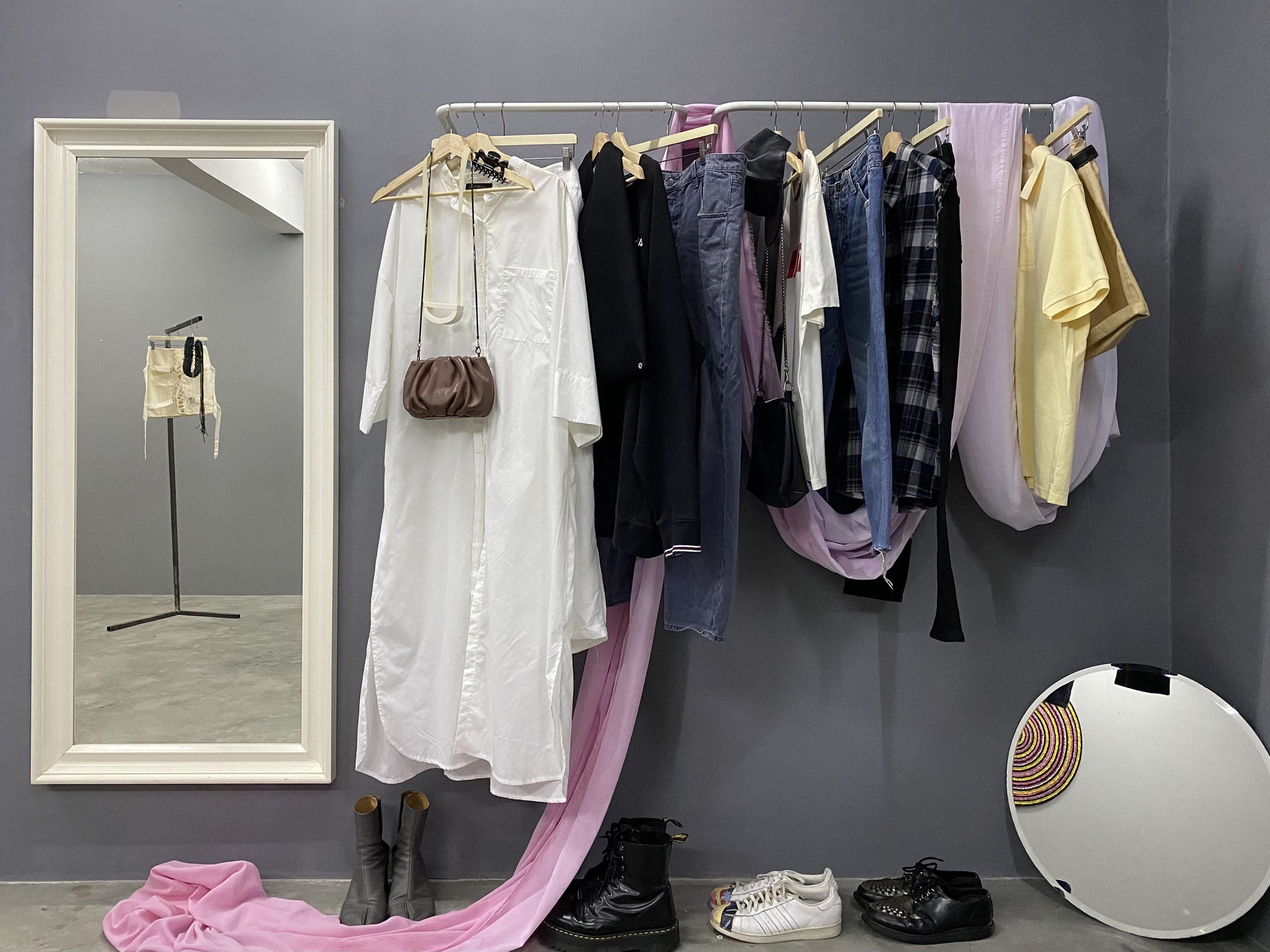Queering Through Dress: ‘Dress/Address’ at Grey Projects
Yeong Jun Bo, Shawna Wu, Samuel Xun and Shika
By Weiqi Yap
Yeong Jun Bo, ‘The Walk-in Closet’. Image courtesy of Weiqi Yap.
In Charlie Porter’s recent book, ‘What Artists Wear’,¹ the longtime fashion journalist notes that much of his job revolves around writing about clothing up until the point of production. “The language of fashion is founded in conjecture,” he writes. “Clothing can be much more useful if we are wily in our manner. I’ve often found that, when I ask someone about their clothes, they soon start talking about so much else: how they live, what they do, how they think, what they want. Clothing is a way in.”
At Grey Projects’ 2021 Queer Exhibition, ‘Dress/Address’, clothes provide this way in. The way into the minds and selves of four artists, that is: Yeong Jun Bo, Shawna Wu, Samuel Xun, and Shika. From its title, the show posits clothing as “the externalisation of an internally coherent self”. This exhibition does away with the fantasy-laden conjectures Porter speaks of when we see clothes as fashion; and instead as material artefacts of our lived experiences.
Yeong Jun Bo, ‘The Walk-in Closet’. Image courtesy of Weiqi Yap.
The intimacy of getting dressed is often absent in dress exhibitions. Clothes on display are not allowed to be touched, let alone worn. But in the confines of this grey cube, clothes are encouraged to be touched and worn. Yeong’s installation, ‘The Walk-in Closet’, occupies a corner of the exhibition with a rail of clothing from their personal wardrobe. The clothes are pieces that chronicle Yeong’s own sartorial evolution, chosen to reflect shifts in their relationship with their gender expression and body image. Next to this, a plinth with a collection of their accessories—rings, beaded bracelets, heavy chains—laid out in front of a mirror for visitors to preen, if one wishes to do so. Multiple mirrors, in fact, are positioned strategically for visitors to look at themselves in pieces borrowed from ‘The Walk-in Closet’.
One could argue that these clothes on display are suspended from fashion, yet the insistent connotations to fashion come through Yeong’s background in styling, and the labels of the garments: a Ling Wu bag, a pair of Margiela Tabi boots, a Uniqlo polo shirt. Selecting and laying out personal pieces as though they are samples for a fashion shoot must have required a degree of distance from Yeong’s present dressed self. These pieces traverse through Yeong’s past sartorial selves, giving new meaning to the fashion magazine jargon, ‘Stylist’s own’. The closet, of course, carries a double meaning here. Referencing the queer experience of coming out (of the closet), Yeong’s work harnesses clothing as invitations to momentarily slip into different skins. Their clothes, when worn by us, become a mutable medium that makes the private act of getting dressed public.
Shawna Wu, ‘Ivory Bound Fanlace Skirt’ and ‘Palace Handknot Beaded Leather’, and Samuel Xun, ‘Everything Reminds Me of Him’, 2021, acrylic paint and glitter ribbon on canvas, ø110x3cm. Image courtesy of Weiqi Yap.
The other garments in the space were by Wu, best known for her sensuous wearable pieces typically made with Chinese butterfly knots, upcycled lace and hand-woven techniques. Two of Wu’s pieces were hung on a steel frame: the ‘Ivory Bound Fanlace Skirt’, and ‘Palace Handknot Beaded Leather’. From the two-dimensional pictures I have only seen on Instagram, Wu’s pieces thicken from image into object when put on. As I tried on the woven leather cord with faux jade beads (which fit round my waist), it became clear that the worn experience is one that cannot be replicated through a screen.
“From the two-dimensional pictures I have only seen on Instagram, Wu’s pieces thicken from image into object when put on. As I tried on the woven leather cord with faux jade beads (which fit round my waist), it became clear that the worn experience is one that cannot be replicated through a screen.”
Contrastingly, Xun’s pieces, ‘That’s The Last Time I’m Watering Your Flowers’ and ‘Everything Reminds Me of Him’, are the first two-dimensional works in his practice. Xun’s works in this show are a departure from his “soft sculpture installations” and plush, maximalist garments per his graduate collection, ‘FEMBUOYANT!’. But they still feel true to Xun’s oeuvre—glitter ribbon is meticulously ruffled and spun into graphic shapes reminiscent of op art. Hung on the wall facing each other, the two pieces are placed in knowing conversation with each other with their tongue-in-cheek titles. Though technically unwearable, there is a wry self-awareness to the textile-based work that knows they may come across as ornamental or decorative—but these pieces continue to demand attention, even on a wall. It would be interesting to contemplate how Xun situates these ‘unwearable’ works against his wearable body of work, given his frequent explorations of Singaporean queer identity through overtly camp garments.
Samuel Xun, ‘That’s The Last Time I’m Watering Your Flowers’. Image courtesy of the artist and Grey Projects.
The interplay between dimensions does not end with Xun’s work, though. The show extends online with Shika’s work, which takes the form of a series of animated GIFs, ‘Trans/Shaman’. Looking at the “intersectionality of queer identities in Southeast Asian shaman culture”, the GIFs depict shamans as gaming characters in pixellated regalia. Religious wear, unlike everyday wear, often remains unchanged throughout centuries. Spiritual intermediaries in Southeast Asia have long resisted the gender binary: the nat kadaw of Myanmar, the bissu of the Indonesian Bugis people, the manang bali of Sarawak. The dressed figures in Shika’s works are pixelated and in looped motion, suggesting that even in practices as long-standing as shamanism, there are intersections of identity that are in perpetual flux.
Shika, ‘Trans/Shaman’. Image courtesy of the artist and Grey Projects.
Clothes in exhibitions are usually deracinated from their most relatable state—to be worn. Usual fashion exhibition apparatus—mannequins, labels, vitrines, enlarged illustrations—are not found in ‘Dress/Address’, and have instead been replaced with the permission to touch and wear. Conservational concerns are usually the reason for this. Exhibited garments are typically fragile, on loan from a private or institutional collection, and therefore put behind glass; or at best, donned by a mannequin. In its exploration of queerness through dress, then, ‘Dress/Address’ also actively queers the fashion exhibition.²
“In its exploration of queerness through dress, then, ‘Dress/Address’ also actively queers the fashion exhibition.”
It is also important to note that while encouragingly increasing, exhibitions of dress in Singapore remain limited. ‘Dress/Address’ hence marks a notable shift for the local fashion curation landscape, particularly with its curatorial premise on queerness. Though small, the exhibition suggests the start of using dress—and the intimacy of wear—as a vehicle to question ideas beyond nation-mandated narratives.
Notes
Porter, Charlie. What Artists Wear. Penguin Books, 2021.
For a detailed address on the queering of fashion exhibitions, see Horsley, Jeffrey. “Exhibiting Biography: Queering the Fashion Exhibition”, European Fashion Heritage 2019 International Conference, 2019.
‘Dress/Address’ is on view at Grey Projects through 20 November 2021. Over four Saturdays in October and November 2021, Grey Projects is organising ‘Walk Walk Don’t Run’, a series of free open studio walks happening island-wide, involving over 35 artists, design studios, and craft spaces across Singapore. More details in a preview over at FAM’s sibling site A&M here.















